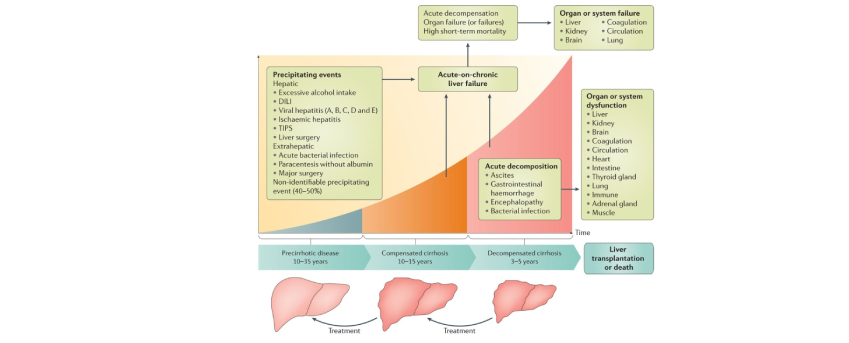Acute-on-chronic liver failure:
Acute-on-chronic liver failure (ACLF) is a distinct syndrome of liver failure in a patient with chronic liver disease presenting with jaundice, coagulopathy and ascites and/or hepatic encephalopathy, developing following an acute hepatic insult and associated with high 28-day mortality. The definition though lacks global consensus, excludes patients with known distinct entities such as acute liver failure and those with end-stage liver disease. The initial Systemic Inflammatory Response Syndrome (SIRS) because of cytokine storm in relation to acute insult and/or subsequent development of sepsis due to immunoparalysis leads to extrahepatic organ failure. These cascades of events progress through a ‘Golden Window’ period of about 7 days, subsequent to which majority of the patients develop complications, such as sepsis and extrahepatic organ failure. Prevention of sepsis, support of organs and management of organ failure (commonly hepatic, renal, cerebral, coagulation) and early referral for transplant is crucial. The APASL ACLF research consortium (AARC) liver failure score is a dynamic prognostic model for management decisions and is superior to existing models. Aggressive multidisciplinary approach can lead to a transplant-free survival in nearly half of the cases. The present review provides an algorithmic approach to management of organ failure, sepsis prevention, use of dynamic prognostic models for management decision and is aimed to improve the skills for managing and improving the outcomes of such critically ill patients.
Purpose of review:
Hospitalizations due to complications of cirrhosis continue to rise. Patients with chronic liver disease who suffer acute decompensation [acute-on-chronic liver failure (ACLF)] often require intensive care support and are at high risk for short-term mortality. Given the high mortality rate associated with this condition is incumbent on intensive care providers who care for this patient population to have a working knowledge of ACLF with its associated complications, management strategies and prognosis.
Recent findings:
Recognizing ACLF as a distinct clinical entity has gained international attention in recent years though a consensus does not exist. There has been progress on better defining this clinical entity and recent studies have begun to address the critical care needs of these patients. Additional studies are required to define the best care practices for patients with ACLF.
Summary
ACLF is a condition occurring in patients with chronic liver disease which is commonly associated with a need for intensive care support and carries a high risk of short-term mortality. Intensive care specialists must be familiar with diagnosis and management of this condition.



